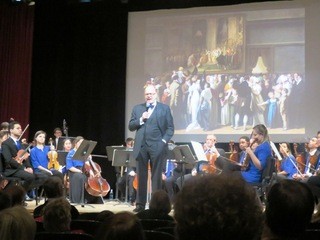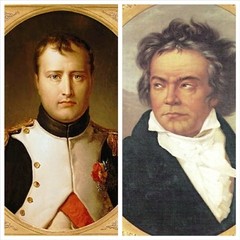|
Back
Lives of the Heroes New York
Grace Rainey Rogers Auditorium, Metropolitan Museum of Art
12/06/2015 -
“Sight And Sound: Beethoven, Boilly and the Heroic Style”:
Ludwig van Beethoven: Symphony No. 3 (“Eroica”), opus 55
Louis Léopold Boilly’s The Public Viewing David’s “Coronation of Napoleon” at the Louvre
The Orchestra Now (TŌN), Leon Botstein (Music Director/Conductor)

L. Botstein, TŌN Orchestra, L.L. Boilly’s The Public Viewing David’s “Coronation” at the Louvre (detail) (In Metropolitan Museum of Art)
(© Samuel A. Dog)
Paul Griffiths holds the gold standard for that large unruly horde of program-note scribes (including this writer). Leon Botstein, though, is in a class by himself when it comes to exegeses in his concert-hall annotations, since he effortlessly relates his words on music to its historical, historical, ethnic and political context.
True, some writers feel that concert pieces must speak for themselves (with a bit of urging and explanation). But as Maestro Botstein explained yesterday, “Don’t imagine that the inspiration necessarily comes before the commission.” Composers have to eat, he surmised. And their dinners–whether coming from aristocrats (Haydn), theater managers (Monteverdi) or Broadway angels (Bernstein) makes all the difference.
Which brings us to Leon Botstein’s newest project. Not content with being conductor, writer, lecturer or (incidentally) President of Bard College), he founded a new orchestra of young players with the questionable name The Orchestra Now (and a terrible punny shortened form, TŌN). But they have best intentions in his series at the Metropolitan Museum of Art, describing music and the paintings of their time.
His basic painting was Louis Léopold Boilly’s The Public Viewing David’s “Coronation” at the Louvre, an early 1800’s idea resembling Rembrandt’s Aristotle Looking at a Bust of Homer. The real subjects, though, were two titans of this period: Ludwig van Beethoven and Napoleon Bonaparte.

N. Bonaparte, L. van Beethoven
Here Mr. Botstein commenced his lecture, both historical, musical and (dare I say it?) conjectural.
Historically, he saw an age which looked back to the heroes of Rome and Greece, he mentioned Beethoven’s voracious study of Ovid and the other classics. Through the paintings, he produced this new love of nature. And a delightful idea that, through burgeoning cities, some were less than delighted that the great parks and forests were being decimated.
Musically, Mr. Botstein compared audiences which merely listened to Classical music to those composers like Beethoven who were “consciously revolutionary”, who were producing ideas rather than simply notes.
This is simplifying Mr. Botstein’s more than fecund mind. When he analyzed–through musical examples by the TŌN–the conductor was on less sturdy grounds. Yes, we know that the “Eroica”–the Heroic–was originally dedicated to Napoleon, who the composer greatly esteemed. But the composer revered the military genius only as First Consul. Once he declared himself Emperor, Beethoven excised Napoleon’s name from the title page.
At the same time, his biographer wrote, “He flew into a rage and said, ‘Is he nothing more than an ordinary human being?...Now he will trample on the rights of others.’”
That, though, is the only record we have of Beethoven’s attitude to the Third Symphony besides its great subtitle. Mr. Botstein ideas were fascinating but on less scholarly grounds. The first theme is obviously “heroic” (though even that word is not quite musical), yet one might not think that the development showed the shortcomings of heroism.
I was personally surprised to hear that he had written the last movement before the others. But am not quite convinced that variations on a theme (from an early ballet about Prometheus) was actually about Prometheus. It could have been, since Beethoven was convinced that he was bringing enlightenment to the People. Or it could have been a pretty tune from which majestic variations could be made.
The Funeral March was, yes, about the attitude to death (with illustrations of death masks on the screen), and the Scherzo probably was Beethoven’s adulation of nature.
So, if conjectural, if not “scientifically proven” Beethoven, it was Mr. Botstein’s personal elucidation on the “Eroica”, so not the less enlightening.
The intermission was not wasted time, for the Grace Rainey Auditorium is in the midst of the Met’s Egyptian section. After the words on art, heroism and death, we wandered through ancient Pharonic and Greek relics of all three before a return to the complete Third Symphony.
The TŌN is not the Philharmonic, not even Botstein’s American Symphony Orchestra. But its 40-odd members (which Mr. Botstein said was probably a good Beethoven collection) played the music with confidence and youthful spirits. The sounds were not grand in the Grand Tradition, yet one felt they could have been close to the sounds produced in 1805.
As for the TŌN itself, they will be giving further concerts–and Mr. Botstein, after this first essay, will produce more affinities between composers and painters, possibly suppositional but, from the voice of the conductor, equally illuminating.
Harry Rolnick
|